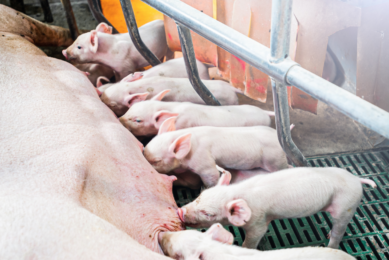Germany: Percentage boar taint stinkers much higher
The Bavarian State Institute of Agriculture has examined as part of a fattening test the effect of inulin administration on skatole concentration—one of the compounds of boar taint. The institute also concluded that more boars with tainted meat enter the consumer food chain than slaughterhouses claim.
The scientists reported a remarkable detail from the fattening test: if all male piglets born would be fattened without being castrated, then the availability of substances known to reduce skatole in the carcass would be quickly exhausted. They also report that adding inulin tends to form clumps in the feed.
The investigation also contradicts the figures released by the pork industry, that claim that only 3-6% of boars at slaughter express a urine-like odour. In the experiment a significantly higher percentages of ‘stinkers’ were found.
The scientists made an extrapolation: If a male pig with a clear boar taint would be classified as unfit for human consumption (and would not be made fit for human consumption or be given a special treatment), then following strict skatole and androstenon limits and “sensitive” testers nationwide, about 10 million boars would be excluded from human consumption.
Guaranteed market
German magazine Der Spiegel reported that recently meat giants Tönnies, Vion and Westfleisch guaranteed their suppliers a market for uncastrated boars without a price discount.
German magazine Der Spiegel reported that recently meat giants Tönnies, Vion and Westfleisch guaranteed their suppliers a market for uncastrated boars without a price discount.
For early detection of carcasses having boar taint the companies’ “private sniffers” would work next to the official meat inspection people at the slaughter line to detect stinkers.
A closer look at the proposed policy shows the risks that such a policy would produce. It is assumed that the three meat giants, with a market share of around 55%, will slaughter about 15 million boars per year. If only 3% of these boars express a more or less pronounced taint, then this adds up to 450,000 carcasses with odour problems.
It is doubtful whether the Dutch and British buyers of such carcasses will accept this without complaint or discount.
From a carcass about 500 servings are made, which must be processed by blending and flavouring to mask the boar taint. This would result in 225 million “masked” portions on the market.
Women decide
If only 0.1% of these portions slip through the process insufficiently or completely untreated in the routine and hectic pace of everyday business, it would mean that 225,000 servings in the food retail would be judged as “stinky”, “disgusting” and “tasting foul” by consumers.
If only 0.1% of these portions slip through the process insufficiently or completely untreated in the routine and hectic pace of everyday business, it would mean that 225,000 servings in the food retail would be judged as “stinky”, “disgusting” and “tasting foul” by consumers.
Since about 70% of all food is bought and prepared by women, who are more sensitive to the smell of boar taint than men, the risk of detecting ‘stinky’ meat is above average.
Surely this is not good publicity for pork, and a woman who has once cooked tainted meat might choose for beef or poultry or vegetarian the next time she goes for grocery shopping, Der Spiegel concludes.











